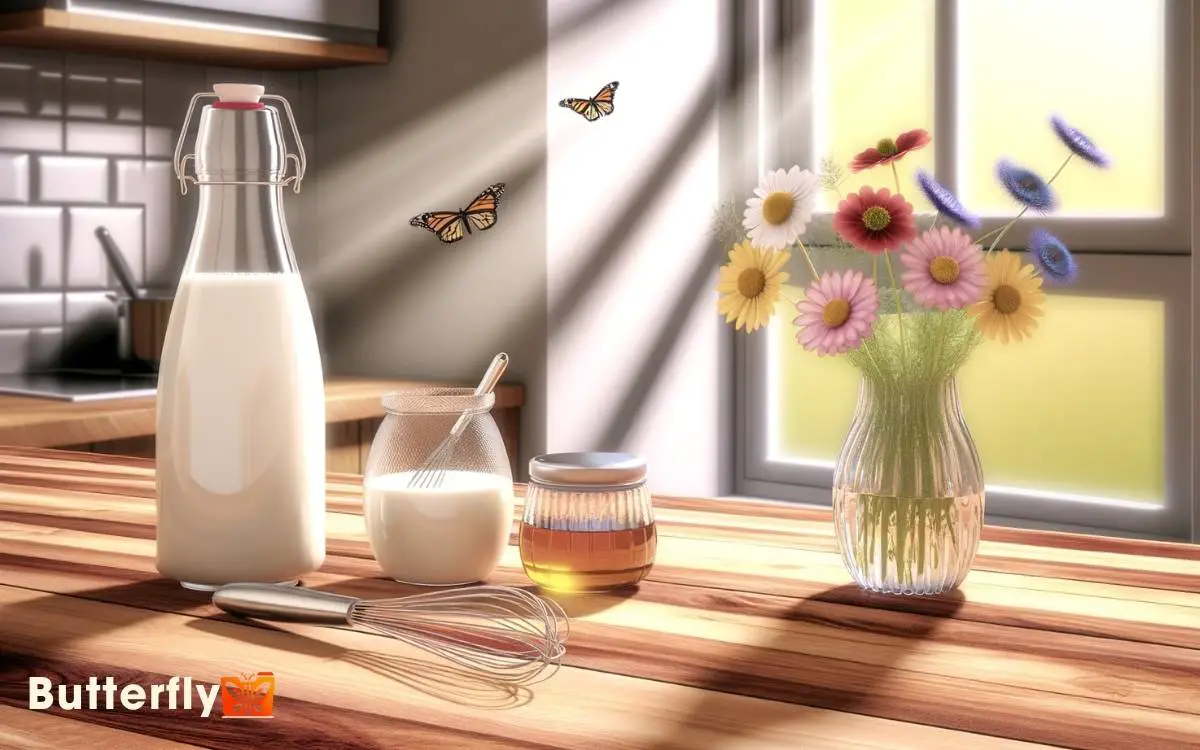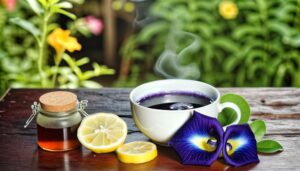How To Make Butterfly Milk? Step-by-Step Guide!
To make butterfly milk, start by brewing a strong tea using dried butterfly pea flowers. Sweeten your tea with high-grade honey or maple syrup to balance flavors.
Choose your milk base, whether it’s whole, skim, oat, or almond milk, depending on the texture you prefer.
Gradually mix the tea with the milk, whisking thoroughly to achieve a uniform blend. Add fresh lemon juice for a delightful color change and top with your favorite garnish.
Serve immediately for best freshness. For a richer experience, explore detailed steps and tips to perfect your butterfly milk creation.

Key Takeaways
Gather Your Ingredients
To begin, you’ll need to meticulously gather all necessary ingredients for making butterfly milk, ensuring each component is fresh and of the highest quality. This includes sourcing organic nectar, fresh fruits, and a specially prepared sugar-water solution to ensure optimal nourishment. Understanding how to feed butterflies properly is crucial, as their delicate digestive systems require carefully balanced nutrients. By maintaining these high standards, you can create a rich and beneficial mixture that supports their health and vitality.
- Start with butterfly pea flowers, scientifically known as Clitoria ternatea, renowned for their vibrant blue pigment and antioxidant properties.
- Obtain organic coconut milk, as it provides a significant, creamy base and enhances the overall flavor profile.
- Acquire high-grade honey for its natural sweetness and antimicrobial benefits.
- Finally, secure a fresh lemon, essential for its acidity which catalyzes the color transformation in the pea flower extract.
Make sure all ingredients are free from contaminants, stored in ideal conditions, and sourced from reputable suppliers. This precise selection process will yield a superior, innovative butterfly milk formulation.
Prepare the Butterfly Pea Tea
First, choose high-quality dried butterfly pea flowers to guarantee vibrant color and potency.
Measure 1-2 teaspoons of the dried flowers per cup of water to achieve the desired intensity.
Steep the flowers in hot water for 5-10 minutes until the liquid reaches a deep blue hue.
Select Quality Dried Flowers
Selecting high-quality dried butterfly pea flowers is crucial for achieving a vibrant and flavorful tea infusion. Begin by examining the coloration; top-notch flowers exhibit a deep, cobalt blue hue, indicating robust anthocyanin content.
Inspect the petals for uniformity and absence of discoloration, as inconsistency may suggest superior quality or improper drying.
The aroma should be subtly earthy yet fresh, devoid of any musty or overly herbaceous notes. Utilize a moisture content test by gently crushing a petal; it should be crisp, not pliable or damp.
Prioritize sourcing from reputable suppliers who employ organic farming practices to guarantee purity and maximum bioactive compounds. This methodical selection process ensures a superior starting point for your innovative butterfly milk creation.
Measure Proper Tea Quantity
After securing high-quality dried butterfly pea flowers, accurately measure the appropriate tea quantity to guarantee the best flavor and color for your butterfly milk.
Use a precision digital scale to measure 2 grams of dried flowers. This guarantees the concentration of anthocyanins, which impart the vibrant blue hue, is at its peak.
Place the measured flowers into a glass or ceramic container to avoid reactive interference. This step is vital because the tea’s intensity directly affects the visual and gustatory experience of your butterfly milk.
Additionally, consider the water-to-tea ratio, maintaining 1 gram of dried flowers per 100 milliliters of water for a consistent infusion. By methodically measuring, you ensure a reproducible and high-quality outcome every time.
Steep for Optimal Color
To achieve perfect color, steep the butterfly pea flowers in hot water at exactly 90°C for 5-7 minutes. This precise temperature and duration guarantee ideal anthocyanin extraction, yielding a vivid blue hue. Utilize a digital thermometer to monitor water temperature accurately.
During steeping, observe the gradual infusion of color, evolving from a faint tint to a deep, rich blue. Agitate the mixture gently to ensure consistent extraction.
Post-steeping, strain the flowers immediately to prevent excessive extraction, which could lead to a bitter taste. Your infusion should exhibit a saturated color, indicative of successful anthocyanin release.
This vibrantly colored tea is now ready for the subsequent steps in creating your innovative butterfly milk.
Sweeten the Mixture
To sweeten the mixture, you’ll need to choose natural sweeteners such as honey or maple syrup.
Observe how these sweeteners harmonize with the butterfly pea tea, ensuring you balance flavors perfectly.
Gradually adjust the sweetness, adding small amounts until you achieve the desired taste profile.
Choose Natural Sweeteners
When selecting natural sweeteners for your butterfly milk, prioritize options like honey, agave nectar, or stevia due to their lower glycemic indices and natural composition.
Honey, rich in antioxidants and enzymes, imparts a complex flavor profile while aiding in maintaining stable blood sugar levels.
Agave nectar, derived from the blue agave plant, offers a fructose-rich alternative, guaranteeing a smooth consistency and enhanced sweetness.
Stevia, extracted from Stevia rebaudiana leaves, provides a zero-calorie option, ideal for those monitoring caloric intake.
Methodically measure your chosen sweetener to achieve the desired sweetness without overpowering the natural flavors of the butterfly pea flowers.
Stir the mixture meticulously to ensure uniform distribution, improving the overall sensory experience and nutritional value of your innovative butterfly milk.
Balance Flavors Perfectly
Achieving the perfect balance of sweetness in your butterfly milk requires a meticulous approach, making sure that the natural flavors of the butterfly pea flowers complement rather than overwhelm the palate.
Start by measuring an exact amount of your chosen natural sweetener, such as honey or agave syrup. Utilize a precise digital scale for accuracy. Add the sweetener gradually, stirring continuously to guarantee even distribution.
Observe the mixture’s viscosity and color changes; these are indicators of proper integration. Conduct a sensory evaluation by tasting small samples after each addition.
This iterative process allows you to calibrate the sweetness levels, achieving an ideal flavor profile that retains the botanical notes of the butterfly pea flowers without overshadowing them.
Adjust Sweetness Gradually
Begin by incorporating your chosen sweetener incrementally, making sure each addition is thoroughly mixed before proceeding to the next. Employ a systematic approach by adding small, measured quantities, then stirring until the sweetener is fully dissolved.
Taste the mixture after each addition to gauge the sweetness level accurately. Utilize precise instruments, such as a digital scale, to guarantee consistency and reproducibility of results.
Observe how the flavors interplay with each incremental increase, adjusting based on empirical observations.
Monitor the mixture’s viscosity and solubility properties, as excessive sweetness can alter its texture. Document each adjustment meticulously to refine the recipe for future iterations.
Choose Your Milk Base
Selecting the best milk base is crucial for ensuring the chemical stability and desired viscosity of your butterfly milk. Start by considering fat content, which directly impacts the emulsion dynamics and mouthfeel.
Whole milk offers a rich, creamy texture, while skim milk provides a lighter, more aqueous consistency.
For plant-based alternatives, oat milk’s higher protein content can enhance structural integrity, whereas almond milk delivers a subtle nutty undertone without compromising fluidity.
Next, assess the pH level compatibility with added ingredients, as it influences curdling risks. Conduct a small-scale test to observe interactions.
Don’t overlook lactose-free options if catering to dietary restrictions; their enzyme-treated composition maintains traditional sensory profiles.
Methodically selecting your milk base sets the stage for a successful butterfly milk formulation.
Mix and Combine
To create the perfect butterfly milk, meticulously measure your chosen milk base and gradually introduce the initial blend of butterfly pea flower extract, ensuring a consistent and homogenous mixture.
This step is vital to achieve the desired hue and flavor profile. Employ a whisk to blend thoroughly, observing the color transformation and uniformity.
| Step | Action | Observation |
|---|---|---|
| 1 | Measure milk base | Ensure precise volume for consistency |
| 2 | Add pea flower extract | Gradual addition prevents clumping |
| 3 | Whisk mixture | Achieve homogenous blend |
| 4 | Inspect color | Vibrant blue indicates thorough mixing |
Add Toppings and Garnishes
After achieving a uniform and vibrant mixture, enhance your butterfly milk by carefully adding selected toppings and garnishes to elevate both its visual appeal and flavor complexity.
Begin by sprinkling a precise amount of edible flowers, such as violets or pansies, to introduce an aromatic element.
Next, incorporate chia seeds for a textural contrast and nutritional value. For a touch of sweetness, drizzle a controlled portion of agave nectar.
To further augment the visual spectrum, consider adding a few drops of natural food coloring around the perimeter, creating a marbled effect when stirred.
Serve and Enjoy
Once your butterfly milk is impeccably adorned with garnishes, serve it immediately to guarantee the best freshness and flavor. This safeguards the integrity of bioactive compounds remains intact.
Utilize a thermally insulated vessel to maintain peak temperature. Pour the butterfly milk gently to preserve the molecular structure and aeration achieved during preparation. Observe the iridescent hues and note any effervescence, indicative of proper emulsification.
Encourage your guests to savor the nuanced flavors and examine the intricate layering of textures. Document their sensory feedback for future refinement. Employ a high-resolution camera to capture the aesthetic appeal, an integral aspect of innovative culinary presentations.
Conclusion
As you take your first sip, the vibrant blue hue of butterfly milk dances on your tongue, a symphony of flavors orchestrated by nature.
The delicate sweetness harmonizes with the creamy base, creating a sensory experience that’s both soothing and exhilarating.
Each component, from the meticulously brewed Butterfly Pea Tea to the chosen milk, melds seamlessly, exemplifying scientific precision and artistry.
Indulge in this carefully crafted elixir, and let each sip transport you to a domain where nature and science converge.







безопасная сделка аккаунтов маркетплейс аккаунтов соцсетей
маркетплейс аккаунтов продать аккаунт
аккаунт для рекламы магазин аккаунтов социальных сетей
магазин аккаунтов магазин аккаунтов
перепродажа аккаунтов магазин аккаунтов
маркетплейс аккаунтов безопасная сделка аккаунтов
безопасная сделка аккаунтов маркетплейс для реселлеров
Buy accounts Buy accounts
Account market Account Trading
Sell Pre-made Account Account Catalog
Buy Account Account Selling Platform
Find Accounts for Sale Buy Pre-made Account
Account Selling Platform Account Trading Platform
Account Acquisition Account trading platform
Database of Accounts for Sale Account Market
Account trading platform https://accountsmarketplaceonline.com/
Account trading platform Profitable Account Sales
Sell Pre-made Account Account Purchase
secure account sales accounts market
buy pre-made account account exchange service
account market sell pre-made account
guaranteed accounts ready-made accounts for sale
account selling service account trading platform
account market secure account purchasing platform
account exchange account buying platform
secure account purchasing platform https://accountsmarketdiscount.com/
account buying service account buying platform
account trading platform find accounts for sale
account purchase account purchase
account trading secure account purchasing platform
purchase ready-made accounts sell pre-made account
ready-made accounts for sale purchase ready-made accounts
secure account sales accounts-for-sale.org
buy accounts buy account
accounts market account buying platform
account store account market
database of accounts for sale account catalog
buy account profitable account sales
accounts for sale buy and sell accounts
account trading platform purchase ready-made accounts
account store online account store
account selling platform purchase ready-made accounts